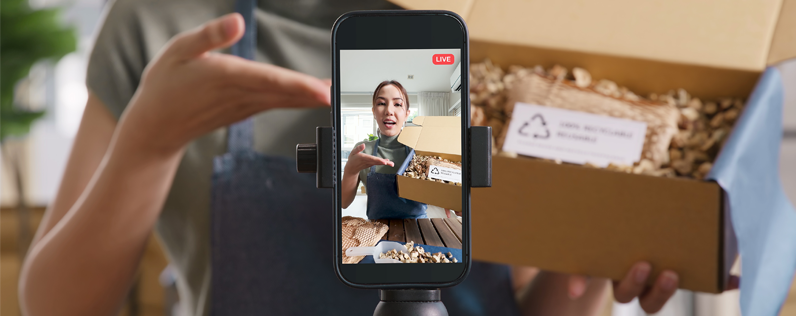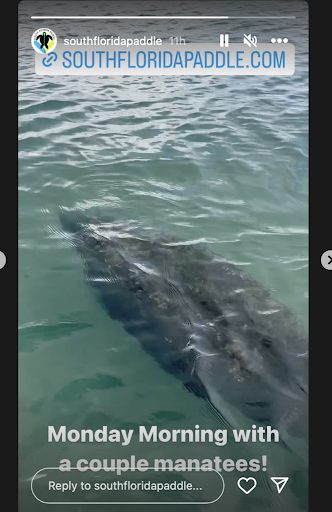
Here’s a secret: I had to set up screen time limits on my own phone because I loved scrolling Instagram so much. I’m not alone. By 2025, there will be a projected 1.44 billion Instagram users worldwide.
And it’s not just for personal use: Marketing with Instagram is a powerful tool for small- and medium-sized companies of all sizes and in nearly all industries. You can create a fun campaign that will get your followers engaged and help new prospective customers learn about your products, services, and overall values.
Trust me, this social media platform draws people in — which is exactly why getting started on Instagram is so worth it for business owners and marketing professionals.
Instagram as a marketing tool
As one of the world’s leading social media sites, Instagram has a business model that is made for marketing. They create a platform that draws attention, and business owners can then utilize paid and organic marketing campaigns to leverage that attention.
In 2023, Instagram users range mostly in age from 18 to 44 years old across both sexes. It’s one of the preferred social media outlets for teenagers, although it’s most popular in households with an income of $100,000 a year or more.
As with all marketing initiatives, the narrower the focus on your target audience, the more likely you can connect with a message that resonates with them. As you determine who your prospects are and how to reach them on Instagram, use data to better understand what your current and future customers are most interested in. Know their pain points, habits, and values so you can create a social ad campaign on Facebook and Instagram to drive traffic to your website.
Why should you be marketing on Instagram?
Marketing works best when you can bring the message to where the people are rather than try to get the people to come to you and your message. Instagram is a social media platform where people spend their time. (Hence, my need for screen time limits to help me use my time wisely!)
Marketing with Instagram has other benefits, too. When businesses embark on a social media campaign on this platform, they can enjoy the time savings that come with social media automation. You can use free tools to schedule posts well in advance of publication, and you can plan ads to run automatically, too.
Behind the scenes, when you set up your Instagram business profile, you can view analytical metrics to determine the success of your campaign in real-time. Instagram Analytics is a free tool that helps you determine if you’re reaching your target audience and provides data-driven guidance for pivoting if necessary.

And finally, Instagram is fun! If your brand wants to embody a relaxed, human tone, the informal style of Instagram Live or Instagram Reels is a great way to do it. If something doesn’t resonate, that’s fine: Content will disappear after 24 hours unless you save it and add it to your Instagram Business profile page under Highlights.
How Instagram marketing works
There are two avenues for marketing with Instagram. First, you can create a paid advertising campaign that will integrate sponsored content into the feeds of targeted Instagram followers. You can create a budget using pay-per-click pricing, which charges you when someone clicks on the ad. You can send them to your profile or a landing page on your website.
Second, Instagram is effective for brands looking to grow a following and raise awareness of their products and services without paying for ads. This method is at the heart of entrepreneurial marketing, as you can maximize the opportunity to connect with your target audience — and their friends — just by staying active on the platform in a strategic way.
Strategies for boosting customer engagement with Instagram marketing
When first starting out, you need to create an effective method to use your limited resources effectively to help you reach your business goals. Integrate these best practices to encourage people to click the “follow” button. After all, that one click can be the first step on a customer journey that ends in a lifetime of sales.
Optimize your Instagram profile
Take your time to set up your business Instagram profile. You’ll want your brand identity to be as clear and consistent here as it is on your website or at your brick-and-mortar store if you have one.
Start the process by investigating the business profiles of your competition. See if they’re doing anything that can inspire you and ways you can improve to help your profile stand out.
The ideal profile picture
If your business has a brand logo, use that as your profile picture. This way, no one will be confused about whether they’ve landed on your official page or a knockoff. If your small business is currently a one-person show and you don’t have a logo yet, a professional headshot helps to literally put a face to the name.
The perfect Instagram bio
You don’t have a lot of room in the Instagram bio — just 150 characters — so, obviously, you’ll need to be concise. Use the space to describe the business and its purpose with as much of your brand’s personality as possible. Add target keywords, hashtags for your brand, and a call to action with a Linktree or other link consolidator to pages you mention in your stories or posts.
Think of this as a digital extension of the elevator speech, where you have just an elevator ride to encourage a prospect to work with your business. In marketing with Instagram, if you don’t nail the bio, your customers will keep on scrolling. Get feedback until you’re satisfied.
The best CTAs
Instagram now lets you add links in the bio for businesses in the form of a pop-up collection of links known as a link tree. The best strategy is to create landing pages for a different CTA with each news feed post. Then, you can track the success of the post through the backend analytics of your website.
At the very least, include a link to your home page that is easily clickable in your Instagram profile bio. This also helps with the credibility and trustworthiness of your brand.
Set clear marketing goals
Now that you’ve got your Instagram profile complete and a clear understanding of your target audience, you’re ready to create a marketing plan. The first step to any good strategy is setting goals. You won’t know if you’ve achieved the results you want if you don’t articulate exactly what you seek.
Some goals could include:
- More visitors to your website
- Increased sales conversions
- Expanded brand awareness
- Strengthened reputation
- Improved customer service
- Constructive feedback on products and services
Take your big goals and break them into measurable objectives with metrics that can track the results. Then, you can begin to craft a content calendar.
Set up a content calendar
The content calendar is the go-to document that outlines the action steps within a goal-focused strategy. It can be a simple spreadsheet with columns that delegate each phase of the task, including the type of content, set publication date, outlined text and images to be used, and the results of keyword research.
The more work you can do in advance, the easier it will be to execute a time-bound plan. You’ll discover that time moves as quickly as a scroll, and you don’t want to be caught in a last-minute scramble to post. It’s always better to have a calendar so team members can know and agree on the plan.
Leverage Instagram stories
A popular way brands can expand their reach on Instagram is through the Instagram Stories feature. This is separate and more casual than the profile page, which stores all your posts that show up in the news feeds of followers. Use your Stories to interact with polls and questions.

Keep it fun with music, hashtags and geo-locators, which get you noticed by people who aren’t following you — yet.
Run contests and giveaways
Perhaps the best part of marketing with Instagram is all the contests and giveaways. So many of my friends will enter contests by sharing a post on their Stories and following a brand profile. It’s free and fun for them, and it’s excellent outreach for the brand. I see it when I’m scrolling through to see what’s new with them. Think about what would motivate your followers to spend five minutes doing the same thing.
Leverage collaborations and influencer marketing
While the word-of-mouth marketing of giveaways is great, influencer marketing can be even more effective — if your brand partners with the right person. If there is an influencer with a strong following of people who are part of your target audience, consider creating a contract to work together. If you can find someone with a smaller following but who resonates with your Instagram followers, that partnership could be more affordable.
You can also collaborate with other brands that overlap an audience, even reaching out to nonprofits that share values with your company. For example, a farm-to-table restaurant may want to partner with an after-school program that teaches children how to grow their own vegetables. Or, a wedding photographer may want to join marketing forces with a catering company. Just because you have an Instagram business account doesn’t mean you can’t enjoy social networking on the platform, too.
Measure success
When your campaign ends, schedule a time to analyze the metrics that relate back to the goal you set at the beginning. Look closely at the data to see if your customers have moved further along the marketing life cycle or whether you’ve met your goals. Measuring your success is the best way to learn from the campaign and improve for next time.
Benefits of Instagram marketing for your business
There are good reasons why so many companies take the time to master social media marketing with Instagram. Here’s a quick wrap-up to motivate you to do the same.
Increased visibility and brand awareness
Especially when you learn how to find hashtags to add to your posts, the Instagram platform is designed to help people find new things to learn about and enjoy. You can expand your reach and improve your brand awareness with a consistent plan for posting.
Cost-effectiveness
While you can certainly spend a lot on pay-per-click sponsored ads on Instagram, you can also work organically — meaning the only cost is the time you or your team put into the platform.
Improved engagement
You’ll see when followers like and comment on your posts. You can send direct messages, post feedback, and really start a conversation on Instagram. And unlike some other social media platforms, it’s almost always positive.
Higher conversion rates
Adding landing pages as calls to action can make it easy for your prospective customers to learn about your brand and make a purchase in just a few clicks. This process is known as a sales funnel, and it works.
Better customer relationships
Not only will your customers learn about your brand, but you can also learn about them. This is a powerful opportunity to deepen your relationship and use what you discover to refine your products and services. That, in turn, will improve your bottom line.
Increased website traffic
Instagram users are already online as they interact with your business profile, so it’s an easy next step on the customer journey to head over to your website. When you get more traffic to the website, you’re on your way to reaching your long-term business goals.
Unlock the power of social media marketing
More than just a fun way to spend time for regular users like me, Instagram is also an effective platform for businesses to get noticed and attract new customers. You’ll be able to reach your goals — and have fun doing it!
As a first step to getting started on Instagram, make sure your brand has an Instagram business profile. Using the best practices you’ve learned, review the profile to see if there are ways to improve it. Look at other brand profiles to see what’s working and to inspire your creativity. When you’re proud of your profile, it’s time to plan out how you’re going to use your platform to reach your target audience.




